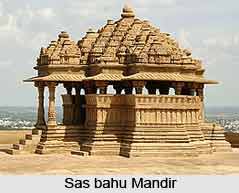 Sas bahu Mandir, Gwalior Fort appears to have been completed in 1093 AD and has an appearence of imposing solidity. But, today, only the cruciform porch, three stories high, survives. Another unusual architectural feature of the Sas bahu Mandir, Gwalior Fort is that the building has been raised several stories high solely with the help of beams and pillars; absolutely no arches have been used for this purpose. The smaller Sas-bahu temple, though much chic in style than the greater Sas-bahu piece, is only the stylistically reduced copy of the latter.
Sas bahu Mandir, Gwalior Fort appears to have been completed in 1093 AD and has an appearence of imposing solidity. But, today, only the cruciform porch, three stories high, survives. Another unusual architectural feature of the Sas bahu Mandir, Gwalior Fort is that the building has been raised several stories high solely with the help of beams and pillars; absolutely no arches have been used for this purpose. The smaller Sas-bahu temple, though much chic in style than the greater Sas-bahu piece, is only the stylistically reduced copy of the latter.
On the road to the fort lies a small temple dedicated to `Chaturbhuj`, the four-armed manifestation of Lord Vishnu. It was built in 875 AD and is believed to be the oldest temple in Gwalior. It has a small dome over its pyramidal roof that corresponds to Teli-ka-Mandir in several aspects.
This article is a stub. You can enrich by adding more information to it. Send your Write Up to content@indianetzone.com





















